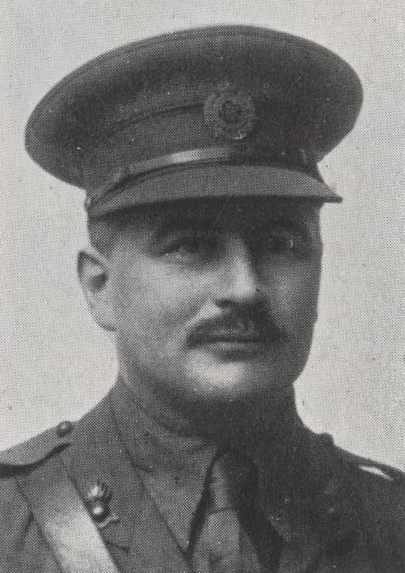
Figure 1. Major Arthur Dunbar Walker, D.S.O., Royal Engineers.
(Image from the Dulwich Record of War Service)
Major
(Acting Lieutenant Colonel)
ARTHUR DUNBAR WALKER, D.S.O.
Royal
Engineers
by
Lieutenant Colonel Edward De
Santis, MSCE, PE, MinstRE
(July 2023)

Figure
1. Major Arthur Dunbar Walker, D.S.O., Royal Engineers.
(Image
from the Dulwich Record of War Service)
1. INTRODUCTION
While this narrative is primarily about the protagonist it also is the story of a military family. Arthur Dunbar Walker’s father was a Major General in the Royal Artillery and his uncle was a Major General of Madras Cavalry. He had two brothers who also served in the Great War of 1914-1918 like he did, one in the Indian Army and one in the Royal Army Medical Corps. The narrative is devoted in detail to Arthur, but sketches of the service of his family members also are provided where information regarding these men could be found. The family trees of each man are presented in the REFERENCE section of this narrative for further investigation by anyone interested.
Family Information[1]
Arthur Dunbar Walker was the son of Major General Alexander Walker, C.S.I., R.A. (1838-1905) and Anne Yewdale Lambert Walker, née Smail (1844-1919), the daughter of Commander William Archibald Smail, R.N. He was the nephew of Major General James Grant Duff Walker, Madras Cavalry (1842-1921). Arthur had two brothers who served with the Forces: Major William Archibald Smail Walker, 46th Punjabis (1874-1915) (See Annex A) and Captain Lewis Augustus Walker, Royal Army Medical Corps (1876-1938) (See Annex B).
Early Life
Arthur Dunbar Walker was born in Fulham, London on 3 July 1879. In May 1891 he entered Dulwich College and remained there until July 1895. After leaving Dulwich he attended the Royal Military Academy at Woolwich, graduating in 1898.[2]
3. COMMISSIONING AND TRAINING
Commissioning
Walker was commissioned a Second Lieutenant in the Royal Engineers at the Royal Military Academy on 23 December 1898.
Training
Following his commissioning he was posted to the School of Military Engineering (S.M.E.) at Chatham, Kent where his military education was continued. At Chatham he received detailed training in field fortifications, construction, surveying, telegraphy, electric lighting, submarine mining, photography, chemistry, military law and tactics. This training lasted about two years before he was posted to his first unit.
4. POSTINGS AND CAMPAIGN SERVICE
India (1898-1904)
After completing his training at the S.M.E., Second Lieutenant Walker was posted to India on 23 December 1898. He had qualified as an Interpreter in French in October 1899[3] and on 3 April 1901 he was appointed as an Assistant Garrison Engineer in the Military Works Service[4] in Jhansi, India.
On 25 July 1901 he was promoted to the rank of Lieutenant. At about this time Governor-General Curzon gained approval from London to send a Tibet Frontier Commission, led by Colonel Francis Younghusband with John Claude White[5] and E.C. Wilson as Deputy Commissioners, to Khampa Dzong. However, it is not known whether the Balfour government was fully aware of the difficulty of the operation, or of the Tibetan opinion of the idea.
On 19 July 1903, Younghusband arrived at Gangtok, the capital city of the Indian state of Sikkim, where John Claude White was Political Officer, to prepare for his mission. It was decided that Younghusband would require a military escort that would consist of a considerable number of engineer units as will be discussed below.
Figure 2. Colonel Francis Younghusband.(Image courtesy of Wikipedia) |
Figure 3. John Claude
White. |
Tibet (1903-1904)
On 15 October 1903 Walker was appointed to the position of Garrison Engineer, but before he could take up this post he was assigned to the 3rd Company, 1st Kings Own Bengal Sappers and Miners as part of the escort for Younghusband’s Mission. The following is a description of the Tibet Campaign and Walker’s part in it as provided in The Indian Sappers and Miners by Lieutenant Colonel E.W.C. Sandes, D.S.O., R.E., with minor adjustments to the format of dates and times:
“The composition of Colonel Younghusband's military escort is worthy of remark. It included a section of No. 7 (British) Mountain Battery with two 10 pr. B.L. guns, two 7 pr. R.M.L. guns allotted to the 8th Gurkhas, a Maxim Gun Detachment of the Norfolk Regiment, the 3rd (Bengal) and 12th (Madras) Companies of Sappers and Miners, and the 8th Gurkhas and 23rd and 32nd Sikh Pioneers. Of its 3,000 fighting men, two-thirds were Sappers or Pioneers and it was commanded by a Royal Engineer, Major (temporary Brig.-General) James Ronald Leslie Macdonald.”[6]
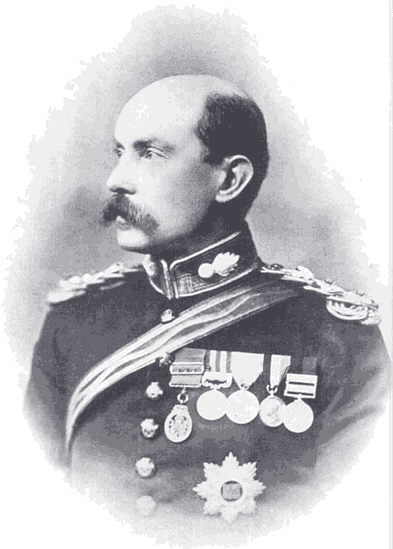
Figure
4. Colonel James Ronald Leslie Macdonald, R.E.
(Image
from the author’s collection)
“Twenty other Royal Engineer officers served with it, and consequently the expedition to Tibet may be called with some justification an" Engineer War." The Government was fully aware of the hardships to be endured. Every man was issued with a long sheepskin overcoat (poshtin), a quilted rug (rezai), fur-lined gloves, lambskin vests, extra socks, felt knee-boots, a woolen comforter and, as a precaution against snow-blindness, a pair of goggles. It was well that this was done for so bitter was the cold during the winter months that the machine-gun jackets had to be filled with a mixture of water, rum and kerosene oil to prevent freezing and it was impossible even to lubricate the locks of the rifles.”
“Before describing the exploits of the Sappers and Miners on the road to Lhasa it may be well to deal briefly with the general course of the operations. The first phase, from 15 October 1903 to 24 March 1904, included the occupation of the Chumbi Valley and preparations for the advance to Gyantse. At the end of 1903 the enemy were concentrated around the Mission at Khamba Jong, apparently anticipating an advance from that place, and thus they were outwitted when the Mission withdrew into Sikkim simultaneously with the beginning of the main advance into the Chumbi Valley from the southwest. The Mission crossed the Jelep La on 13 December and occupied Chumbi on the 15th. A flying column was pushed forward on 20 December to Phari Jong where the garrison surrendered, thus completing our hold on the valley. On 7 January 1904, the Mission crossed the Tang La (15,700 feet) to the bare plateau of Tuna (15,300 feet) and remained there throughout the winter with an escort of 4 companies of Pioneers and a detachment of Madras Sappers under Lewis. Macdonald led the rest of the troops back to Chumbi. The collection of supplies at Phari was completed by 24 March and so the first phase came to an end.”
“The second phase, from 25 March to 12 June 1904, comprised the advance to Gyantse and preparations for the march to Lhasa. On 29 March, the Gyantse column was at Tuna facing 3,000 Tibetans at Guru and 2,000 at Harm. A further 2,000 Tibetans were distributed along the route northwards from the Kala Tso to Gyantse. The Guru force attacked the Gyantse column and was defeated, and as the Harm force then retired to beyond the Kala Tso the advance was resumed on 4 April after reinforcements had arrived. On 10 April Macdonald drove the enemy from their positions in the Zamdang (or Red Idol) Gorge and occupied Gyantse on the following day. The Mission and its escort took up their quarters in an adjacent hamlet called Junglu which Lieut.-Colonel Herbert Ralph Brander, 32nd Sikh Pioneers, was detailed to hold with a garrison of 500 infantry and sappers with two guns. This having been arranged, the remainder of the force began its return march to Chumbi on 19 April. Brander started out on 2 May with a Movable Column, and four days later, by flank attacks over almost inaccessible heights, defeated 3,000 Tibetans on the Kharo La (16,600 feet). Meanwhile, an enemy force of 1,600 men from Dongtse had occupied the Gyantse Jong after failing to overwhelm the depleted garrison of the Mission Post. For the next two months the Mission was practically besieged; but a reinforcement of 200 men, including a composite half-company of Sappers and Miners under Captain Seymour Hulbert Sheppard, R.E.,[7] with two 10 pr. guns, having been sent to Brander; the latter was able to maintain an active defence and even to extend his position by the capture of a building called Gurkha Post on 19 May and the village of Palla on 26 May, and thus the Tibetans were kept too busy to interfere seriously with our communications.”
“The third phase from 13 June to 3 August 1904, included an advance in force to Gyantse, the capture of the Gyantse Jong and an advance to Lhasa. By this time, the enemy had collected 8,000 men in Gyantse and had established outpost forces at Khangma, Niru, Gabzi and Niani to the south and southeast and a reserve in the Tsechan Monastery on the road to Shigatse. Macdonald arrived from Chumbi with strong reinforcements on 26 June after driving the Tibetans from Niru, the Zamdang Gorge and Niani. On 28 June he took the Tsechan Monastery, and on 6 July, after fruitless negotiations, assaulted and captured the formidable Gyantse Jong. The way to Lhasa was now open and Younghusband and Macdonald set out on 14 July with 2,100 fighting men, 8 guns, 6 maxims, 2,000 followers and 3,900 animals. At Ralung, on the 16th Macdonald learned that the Kharo La was strongly fortified by sangars and by a wall extending to vertical cliffs at the snow line; but nevertheless he forced a passage in an action during which the Gurkhas fought at 18,500 feet above sea-level and ended by pursuing the enemy across a glacier. Nagartse Jong was seized on 19 July and Pede Jong on the 21st . The advance continued steadily and on 24 July the force surmounted the last pass, the Khamba La (16,400 feet), and descended to the Tsan-po at Partsi. Thence, on the 25th , it marched downstream to Chaksam to attempt a crossing at a spot where the river narrowed. This dangerous operation will be described later. It was accomplished in six days and on 31 July the advance was resumed to Lhasa. At length, on 3 August, Younghusband and Macdonald with only 1,600 men, encamped before the holy city whence the Dalai Lama had fled after his representations had been rejected.”
“The fourth and last phase of the operations included the occupation of Lhasa and the withdrawal to India. The negotiations at Lhasa were protracted, but a treaty was signed on 7 September 1904, in the Throne Room of the wonderful Potala Palace whose golden roofs towered majestically to the sky. Then, all was haste. Winter was approaching and the passes would soon be blocked by snow. On 9 September, the Sappers set out with some infantry for Chaksam to arrange for re-crossing the Tsan-po but decided in favour of an easier site at Partsi as more equipment had arrived. Younghusband and Macdonald evacuated Lhasa on the 23rd and the whole force crossed at Partsi between 27 and 29 September. From Partsi the force marched in two columns to Gyantse where it arrived on 5 and 6 October. A survey party under Captains Charles Henry Dudley Ryder[8] and H. Wood, R.E., was sent to reconnoiter Western Tibet and the troops returned to India in small columns. This, briefly, is the record of the Tibet Mission. We turn, now, to the achievements of the Sappers and Miners without which such rapid success could never have been secured.”
“On November 1903, the 3rd Company, Bengal S. & M., under Captain Seymour Hulbert Sheppard, R.E., with Lieutenants E. F. J. Hill,[9] Arthur Dunbar Walker, C. H. Haswell and G. F. B. Gough, R.E., arrived at Siliguri from Roorkee and was sent to work at once on a new cart-road near Gantok. In December it was engaged with half the 12th Company, Madras S. & M., on roadmaking from Gantok towards the Nathu La; but when the Madras Sappers moved to the Chumbi Valley in January 1904, the 3rd Company took charge of the entire road construction assisted by 1,100 coolies. Snow fell on 16 February. The men were then working on the Lagyap La, (10,700 feet) some 6 miles from Gantok, and from that time till the middle of May they were often in two feet of snow or freezing slush. Huge bonfires were kept burning to thaw them at the end of each hour's work. Some stretches of road were paved in Sikkim fashion with stones on edge, hammered in and covered with gravel: others beyond the Nathu La were " corduroyed " with the trunks of pine trees with a similar top-dressing. On 15 May, the 3rd Company was split up; half remained with Hill and Haswell in the Chumbi Valley and the other half joined a composite detachment under Sheppard which was to proceed to Gyantse. This detachment comprised 60 men of the 3rd Company under Walker and 20 men of the 12th Company, Madras S. & M., under Garstin. Hill's half-company labored for the next five months on road construction and hut building in the Chumbi Valley. The work was most exacting and a length of one mile of road had to be blasted out of a granite cliff. Meanwhile, Sheppard's composite detachment had reached Gyantse with other troops on 24 May and had reinforced the defenders of the Mission Post at Chunglu.
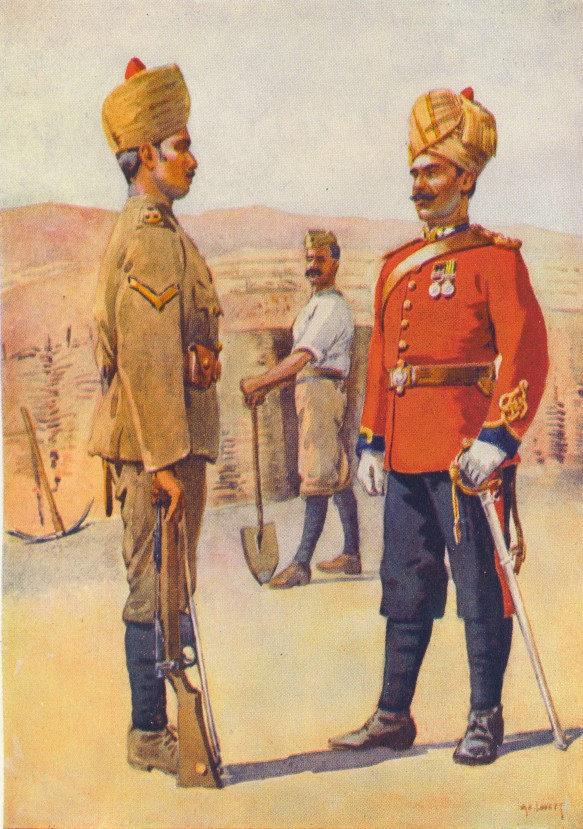
Figure
5. Men of the 3rd Bengal Sappers and
Miners.
(Image from a postcard in the author’s
collection)
“The garrison at Chunglu was subjected to a daily bombardment from the Gyantse Jong which crowned a steep hill 1,000 yards to the north, but there were few casualties owing to the excellent defences contrived by Ryder and Cowie, the Survey officers. Although a fortified house known as " Gurkha Post " formed a strong British outpost, all the other houses and hamlets around Chunglu were held by the enemy who were particularly menacing from the village of Palla, 1,000 yards to the north-east, where they were beginning to mount guns. It was decided, accordingly, that Palla should be stormed without delay and Sheppard was entrusted with the task of opening a way for the infantry. For this purpose he detailed four small explosive parties, each of four men under a British officer. The first he commanded in person. The second, to follow 30 yards in rear, he placed under Captain W. F. T. O'Connor, R.A., a Political Officer who volunteered for this hazardous duty. The third was under Walker; and the fourth, in support of Walker, under Garstin. Two assaulting columns, each of a British officer and 60 men of the 32nd Pioneers, were to follow the explosive parties, and on a mound called " Gun Hill " a reserve was to be stationed consisting of the remainder of the Sappers and two companies of infantry with two mountain guns.”
“The attack on Palla was planned for 26 May and was to be delivered against the side furthest from the Mission Post where the defences might be expected to be weak. A night march, begun at 0230 hours, brought the explosive parties by a circuitous route to within 300 yards of the village before they were discovered and came under fire. They ran forward, and Sheppard collected them under the village wall. Sending Walker towards the first house of the village (the one nearest to the Jong), Sheppard dashed through an open gateway between that house and the second and almost ran into the arms of three Tibetans. Quick as lightning he shot two with his revolver, while the third bolted back into the first house but forgot to shut the door. Sheppard then called up Sapper Chagatta, a soldier who afterwards distinguished himself in France during the Great War. Chagatta appeared with a box of guncotton and, though fired on heavily from all sides, Sheppard laid the charge against the wall of the second house, lit the fuse and retired, the subsequent explosion blowing a good breach in the wall. Walker was successful also in breaching the wall of the first house, and he and Sheppard, back under cover, then looked around for the assaulting columns, but they looked in vain. These columns had been attacked in flank during their advance, and having lost direction, were making their way towards the other end of the village which they entered in due course; so, as Sheppard could find no more than 20 men, he decided that it was possible only to assault the first house in which 6o Tibetans held the upper floor. It seems that Lieutenant G. P. Gurdon of the 32nd Pioneers had already led a few men into this house through the open door-way, and now he re-entered it with O'Connor, and the latter placed a whole box of guncotton in the lower room and lit the fuse; and when the explosion had killed or buried half the garrison, the attackers, rushing in, bayoneted the remainder or shot them as they fled. This gallant exploit, however, entailed many casualties. Only Sheppard, Gurdon, 8 Sappers and 11 Pioneers remained unwounded. Garstin had been mortally wounded, O'Connor and a young Pioneer officer severely wounded, and Walker, one Sapper and four Pioneers slightly wounded. Nearly every man had been hit by stones or bricks, and it was impossible to do more than hold the house. The arrival of the assaulting columns eventually relieved the tension and ended a hard fight. The loss of J. A. Garstin was felt keenly by all ranks because he was very popular. As General Macdonald remarked, he was a most gallant officer who had done excellent work in Sikkim and Tibet. Garstin’s place in the Sapper detachment was taken by Lieutenant Charles Folliott Birney, R.E.”[10]
“After the capture of Palla, a fortified post was established there. Many houses were demolished and a covered way was dug to the Mission Post. To safeguard the line of communication it was necessary to bridge the river skirting the Mission Post as the existing Tibetan bridge had been damaged by gunfire from the Jong, so Sheppard selected a site further upstream where the water was shallow and the width about 150 yards, and in three days, with the help of infantry working parties, the Sappers built a crib-pier bridge which lasted until the Jong was captured. The only timber available was from houses in the vicinity and consequently the spans had to be very short. With the arrival on 26 June of General Macdonald with 3,000 men and 8 guns, preparations were made to take the Tsechan Monastery a few miles in rear of the Jong. This miniature city was attacked on 28 May by the 8th Gurkhas operating from a ridge to the south and by the 40 Pathans and a party of about 20 Bengal Sappers and Miners under Sheppard making a frontal advance across the plain with artillery support. The enemy kept up a heavy though inaccurate fire and held some outlying sangars with considerable tenacity. Sheppard and his men ran forward to the main gate of the monastery, laid a box of guncotton against the gate and lit the fuze, and after the explosion took place they headed the rush into the gateway. Most of the Tibetans fled from the monastery to a fort overlooking it, for their experiences at Palla had inspired them with a wholesome dread of large charges of explosive, and when the Sappers prepared 'to blow down the gate of the fort, they fled again. Major-General Sheppard records that at this time he had a number of Tibetan prisoners working under him cheery fellows who greeted him every morning with thumbs upturned and tongues fully extended in polite welcome. One of these prisoners had been blown up at Palla and being an intelligent man was selected to carry a demand for the surrender of the Gyantse Jong and was promised his pardon if he brought back an answer. He went and returned and was then told that he might go. " Go ? " said he. " Not I ! Why, if I do, he (pointing to Sheppard) might blow me up again."
“The attack on Gyantse Jong on 6 July 1904, began with preliminary operations against some fortified houses and enclosures at the foot of the hill, the chief objective being a double-storied building known as the " Chinese House " standing in a courtyard. The British force emerged from behind Palla before dawn in three columns, each of two companies of infantry preceded by a small explosive party under a Royal Engineer officer. With the Right Column were 12 Bengal Sappers under Captain C. A. Elliott[11] ; with the Centre, a similar party under Captain S. H. Sheppard; and with the Left, 12 Madras Sappers under Lieutenant C. F. Birney. Each party carried several 12-lb. charges of guncotton, ready for instant use, and also a few picks and crowbars. Additional explosive charges and tools were carried by the infantry in rear. The Centre Column was detailed to attack the Chinese House and the other columns to close on it after taking the walled gardens to right and left. The left column encountered little opposition, but the centre and right columns came under heavy fire and took cover in the right-hand gardens until a mountain gun supporting the centre column had planted three shells on the roof of the Chinese House. Then the Sappers made a dash for the entrance gate to the courtyard. Sheppard and Sapper Chagatta laid a charge against the gate while Naik Usman Singh returned the point-blank fire from the enemy's loopholes, and when the charge had been exploded and the gate blown in, the Sappers headed the rush of infantry through the opening. Most of the enemy fled into the house and, after the door had been blown down, jumped from the roof on to the roofs of the adjacent houses and so made their escape. Every house below the Jong was soon empty and the Sappers proceeded to make covered ways through the town to connect the picquets established there. The capture of the Chinese House was followed by an assault on the Jong. At 1400 hours, a company of the 8th Gurkhas, led by Lieutenant J. D. Grant and supported by Royal Fusiliers, began to scale the heights under a hail of bullets and stones, and entering by a breach made by the guns were soon masters of the place. This defeat broke the enemy's resistance and opened the way to Lhasa. The Sappers took no part in the assault on the Jong; but for their exploits at Palla and the Chinese House Sheppard received brevet promotion and Naik Usman Singh and Sapper Chagatta of the 3rd Company were awarded the Indian Order of Merit. The Sapper detachment spent some days in demolishing the defences of the Jong before marching eastwards on 14 July with the column bound for Lhasa.”
“The detachment accomplished a fine performance in providing a ferry across the Tsan-po at Chaksam during the final stages of the advance. The width of the main channel from the end of a rocky promontory on the right bank to a large sand-bank near the left bank was 140 yards, and beyond the sand-bank was a subsidiary channel 25 yards wide. In midstream, above the promontory, another sand-bank had the effect of making the water pour with terrific force past the promontory, thus creating a backwater and whirlpools below it - a dangerous locality for a ferry, yet lack of bridging material prevented the choice of a better site. The stores available were only four Berthon (collapsible) boats with superstructure for two rafts, two large Tibetan ferry-boats and a few small skin-boats, 200 yards of 1-in. steel cable and a traveller, and 640 lbs. of 2-in. and 1 ½-in. manilla rope. With this meagre equipment the Sappers had to transport across the torrent a total of 3,500 men and 3,500 animals with 350 tons of stores. The crossing began at midday on 25 July by rowing the ferryboats and Berthon boats (the latter made up into rafts), but this method was painfully slow. The unwieldy ferry-boats were swept far downstream on each trip and had to be towed up again; and after a Berthon raft had foundered in a whirlpool and Major G. H. Bretherton of the Supply and Transport Corps and two sepoys had been drowned in attempting to swim ashore, the use of Berth on boats for rafting was abandoned. On 26 July several attempts were made to get a line across for the establishment of a flying bridge, but they were unsuccessful and rowing was resumed. The river had risen and only fourteen boat loads made the journey in twelve hours. At such a rate, a fortnight would have been required for the passage of the whole force, and accordingly on 27 July Sheppard resumed his efforts to connect the banks by a line and after two failures succeeded in doing so.”
“Berthon boats were anchored far out from each bank and the boats connected by a line. Other Berthon boats then brought out lines and the crews threw the ends to the men in the anchored boats who caught them and joined them to the connecting line. The 1-in. steel cable was next hauled across by the now continuous line. It was made fast to the high promontory on the right bank and having been passed over a tripod to an anchorage on the sand-bank, the traveller was slung on it. The large Tibetan boats were employed as ferries by using the traveller to carry across one end of a 2-in. rope and then attaching the end of the rope to a boat and allowing the boat to be swung across the river assisted by rowing and hauling. The boats were then unloaded, towed upstream and rowed back empty. By this method the rate of crossing was increased to forty boatloads a day and the whole operation was completed in 5½ days. A small flying bridge of skin-boats sufficed for the narrow channel beyond the sand-bank, and thus the Tibet Mission and its escort were landed safely on the northern shore.”
“During the ferrying operations on the 27th, Sheppard nearly followed Bretherton to a watery grave. He was standing on the high right bank downstream of the steel cable when a towing rope fouled and threw him twenty feet downwards into the rapid backwash below the promontory. His head struck a rock and he was half stunned; but fortunately, as he was being swept upstream, he had just enough strength to cling to a rock at the end of the promontory until a rope was thrown to him. His legs were then almost in the nearest whirlpool, and had he been carried another two yards he would certainly have been drowned. As it happened, he was little the worse for his accident and was able to carry on all day as usual.”
“The Sapper detachment shared in the triumphal progress from Chaksam to the Tibetan capital. "I think," writes General Sheppard, "that the greatest thrill I have ever experienced was when, on the morning of the last march before reaching Lhasa, I climbed a hill and saw in the far distance the dim outline of the Potala with its golden roofs catching the rays of the rising sun." And so, after many hardships and dangers, the goal was attained and the Forbidden City yielded up its secrets.”
“The anti-climax came in an uneventful return to India. Sheppard, Walker and Birney, with their Bengal and Madras Sappers and Miners, marched from Lhasa on 9 September and reached Chaksam on the 11th ; but as reports had been received that a better place for a crossing existed at Partsi, 11 miles upstream, the boats were towed up to that spot with the help of coolies and preparations made at once to provide ferries. Additional stores had been sent from India, including steel cable and another traveller, and the work at Partsi progressed so rapidly that, when the main body arrived from Lhasa, two cable-ferries, one of 105 yards and the other of 140 yards span, were ready for use, supplemented by a rowing ferry of Tibetan skin-boats. The force began to cross on the morning of 27 September, and before midnight on the 28th /29th every man and animal and every ton of stores had been carried to the right bank.”
For his actions commanding the explosives party at Pall where he was wounded, Lieutenant Walker was mentioned in despatches. He did very well in his first operation against an enemy force. For his service during the operation he was awarded the Tibet Medal 1903-1904. Figure 6. The Tibet Medal,
1903-1904 with clasp [GYANTSE]. NOTE: This is not Walker’s medal. It is shown here for illustrative purposes only.
|
|
India (1905-1914)
By January of 1905 Lieutenant Walker was back in India, at Miranshah in the Kohat District, on the banks of the Tochi River in the wide valley surrounded by the foothills of the Hindu Kush mountains. He was again serving as a Garrison Engineer. On 19 June 1905 he was appointed an Assistant Engineer on the North Western State Railway.[12] He would remain with the N.W. State Railway on various duties until his departure from Indian in 1914.
In addition to his state railway duties, Walker also had purely military duties. In December 1905 he was seconded to the 25th Railway Company of the Indian Sappers and Miners.[13] He was promoted Captain on 23 December 1907[14]and in January 1908 he was appointed Assistant Engineer, Grade 2, of the North Western State Railway at Sialkot in the Punjab. From June to December 1908 he served as Temporary Executive Engineer, Grade 3, with the N.W. State Railway at Quetta.[15] He took leave to return to England on 13 May 1909 and did not return to duty in India until 6 October 1909.
In January 1910 he once again was serving as an Assistant Engineer with the State Railway as well as Company Commander of the 26th Indian Railway Company at Quetta. He appears to have retained this position until December 1912 when he moved to Roorkee, still attached to the Sappers and Miners. In April 1914 he was posted to Saharanpur between the Ganges and the Yamuna, the holy rivers of India.
After 16 years of service in Indian and Tibet, Captain Walker was called home to England in preparation for service in the Great War of 1914-1918.
England (1914-1915)
In October 1914 Walker returned to England and on 14 November he was appointed Adjutant on the staff of the Commander Royal Engineers (C.R.E.) of the 18th (Eastern) Division. As Arthur Walker was getting accustomed to his duties in the 18th Division, his brother, Captain Lewis Augustus Walker, R.A.M.C. was posted to the British Mission to Serbia on 16 February 1915.[16] Unfortunately for the Walker family, on 15 April 1915 they received word that a third brother, Major William A.S. Walker, 46th Punjabis, attached to 130th King George’s Own Baluchis (Jacob’s Rifles) was killed in action in East Africa.[17]
William’s death occurred in a
rather unfortunate way. Indian troops including Kashmiris and
Baluchis had been deployed to Mzima in early April but their
bush-craft skills were not, as might be expected, up to the standard
of the German Schutztruppe’s skills. Major Walker had gone out with
Intelligence Agent Chitty, 18 Wateita Scouts & porters and an
escort of seven Kashmir Rifles to look at locations for a proposed
screen of British African Scout observers west of Mzima. (The Wateita
were the local tribe, mainly living in the Teita Hills to the east of
Maktau). Shortly after setting out Walker saw a waterbuck and fired
three shots at it, alerting everybody within earshot, including the
German troops. Intelligence Agent Chitty then found the fresh spoor
of between 40 and 50 enemy heading west towards Campi Ya Maribu, and
he advised Walker to terminate the patrol. Walker, wanting to gain
more information, proceeded for a time until Chitty and the Wateita
refused to go on. The British patrol then turned around. Chitty
advised that a new route should be used for the return journey but
Walker did not think that necessary.
On the return journey a
small enemy group (2 or 3 Germans and 12 Askari) that had been
dropped-off by the main group in order to reconnoitrer Mzima in
daylight, ambushed Walker’s patrol at 20 yards’ range, killing
him, two sepoys, one Scout and Chitty’s cook. The remaining
British troops ran into the adjacent lava-flow.[18]
(See Annex A for a full description of the service of Major W.A.S.
Walker).[19]
The 18th (Eastern) Division was established by the Eastern Command in September 1914, as part of the Army Orders authorizing Kitchener’s Second New Army, K2. Early days were somewhat chaotic, the new volunteers having very few trained officers and NCOs to command them, no organised billets or equipment. The division had few trained and experience officers like Walker, who had already proven himself on active service in India and Tibet. In addition, he had performed his duties there under extremes of weather conditions and would not find the harsh winters of western France a challenge.
The units of the Division initially concentrated in the Colchester area but moved in May 1915 to Salisbury Plain. King George V inspected the Division on 24 June. Captain Arthur Dunbar Walker had been promoted to the rank of Major on 22 June[20] and as the Adjutant he had already taken the engineer units in hand by the time of the King’s inspection. The divisional engineers consisted of the 79th Field Company, the 80th Field Company, the 92nd Field Company and the 18th Divisional Signals Company.
France (1915-1918)
Units of the 18th Division embarkation for France began on 24 July and moved to assemble near Flesselles. The divisional engineers embarked on 26 July and completed concentration at Flesselles five days later.[21] The Battle of Delville Wood was underway at the time and the engineer units of the division had time to take some part in it up to 3 September.[22] From then on the 18th Divisional Engineers took part in numerous critical battles including:[23]
The Battle of Thiepval Ridge, 26 to 28 September 1916.
The Battle of the Ancre Heights in which the Division played a part in the capture of the Schwaben Redoubt and in the capture of Regina Trench, 1 October to 11 November 1916.
The Battle of Ancre, 13 to 18 November 1916.
(In the London Gazette of 4 January 1917 Walker was mentioned in the despatch of General Sir Douglas Haig, G.C.B., General Headquarters, British Armies in France dated 13 November 1916, for his performance of duty during this battle).
The Battle of the Scarpe, 3 to 14 May 1917.
On 20 May 1917 Major Walker was appointed an Acting Lieutenant Colonel and was posted as the C.R.E. on the 24th Divisional Engineers with XIX Corps in the Fifth Army.[24] The units now under his control included the 103rd Field Company, the 104th Field Company, the 129th Field Company and the 24th Divisional Signals Company.[25]
The 24th Division spent the winter months of 1917/1918 in reserve, but the early spring of 1918 brought warning news to the British that the Germans might be planning a spring offensive. On 5 March 1918 the Fifth Army issued orders to all divisions to prepare railway bridges for demolition. Then on 10 March, further orders were issued to order that all light railway bridges (that is, those constructed by R.E. light railway companies) also were to be prepared for demolition. On 20 March XIX Corps, after receiving reports from all divisional engineers, reported that “explosives authorized have been drawn and issued to companies. Exploders in possession of units will suffice.”[26]
On 21 March 1918 the Germans launched their spring offensive. The first offensive, code-named Michael, began on 21 March and was directed against the British 3rd and 5th Armies on a 40-mile front either side of Saint Quentin in the Picardy region of northern France. The aim was to break through into open country, roll up the British line from the south and throw them back in disorder to the Channel coast, separating them from the French Army and causing their respective Governments to sue for peace. To improve their chances of success, the Germans developed radically new tactics. Firstly, to achieve maximum surprise, the traditional weeks-long shelling prior to an attack was to be replaced by a short hurricane bombardment of a few hours duration only. Secondly, rather than wasting time attempting to overcome pockets of resistance, specially selected storm troops equipped with light machine guns, mortars and flame-throwers were to infiltrate the enemy’s positions and, by advancing with great rapidity, capture numerous battalion headquarters to prevent the enemy from organizing a coordinated defence.
The German army had concentrated many of its best troops into stormtrooper units, trained in infiltration tactics to infiltrate and bypass enemy front line units, leaving these strong points to be "mopped-up" by follow-up troops. The stormtrooper tactic was to attack and disrupt enemy headquarters, artillery units and supply depots in the rear areas, as well as to occupy territory rapidly. The British would name this first attack, between 21 and 23 March, the Battle of St. Quentin.
On 21 March the bridges over the River Omignon (forward area bridges) were prepared for destruction by the 24th Divisional Engineers. Lieutenant A.N. Fairbourn of the 103rd Field Company destroyed the Vadencourt-Maissemy bridge in the face of the enemy, and also the bridge southeast of Bihécourt. On 22 March Fairbourn destroyed the Vermand bridges and on the same day the 104th Field Company took part in the defense of Le Verguier with troops of the 17th Brigade. The division headquarters ordered the withdrawal at 1115 hours, but the 104th Field Company did not start until between 1330 and 1400 hours.
During the battle the R.E. units were largely employed as infantry to fill gaps in the fighting line.
The towns of Vermand, Le Verguier, Vadencourt, Maissemy and Bihécourt noted above are shown highlighted on the map in Figure 7 below. These towns are shown straddling the defensive line occupied by the British Fifth Army on 22 March. As the British forces were pushed back by the advancing German offensive, the 24th Division withdrew through a line roughly designated by the towns of Beaumetz, Cartigny, Perronne and Biaches. It was during this withdrawal that Acting Lieutenant Colonel Walker was reported missing by the time the division reached the defensive line of 26 March. He was originally listed as missing and then presumed dead. Walker may have gotten caught up in the late withdrawal of the division, cut off and killed by an artillery shell or perhaps by a flame-thrower, which the Germans were using during their offensive. As the Commander of Royal Engineers in the 24th Division, he may have felt it to be his duty to verify that all of his companies received the order to withdraw and that all were doing so in good order. He may have delayed his own withdrawal by visiting the last known position of each of his companies to verify that they were pulling out. This action on this part would have put him in the rear of the withdrawing division and out of contact with any unit or person who could have witnessed his death. At any rate his body was never recovered. From the map it appears that he probably was killed somewhere in the division area to the west southwest of Peronne and north of Estrées (see the circle area on the map). Walker was 38 years old when he was reported dead. His name appears on the Pozieres Memorial, Panels 10 to 13.
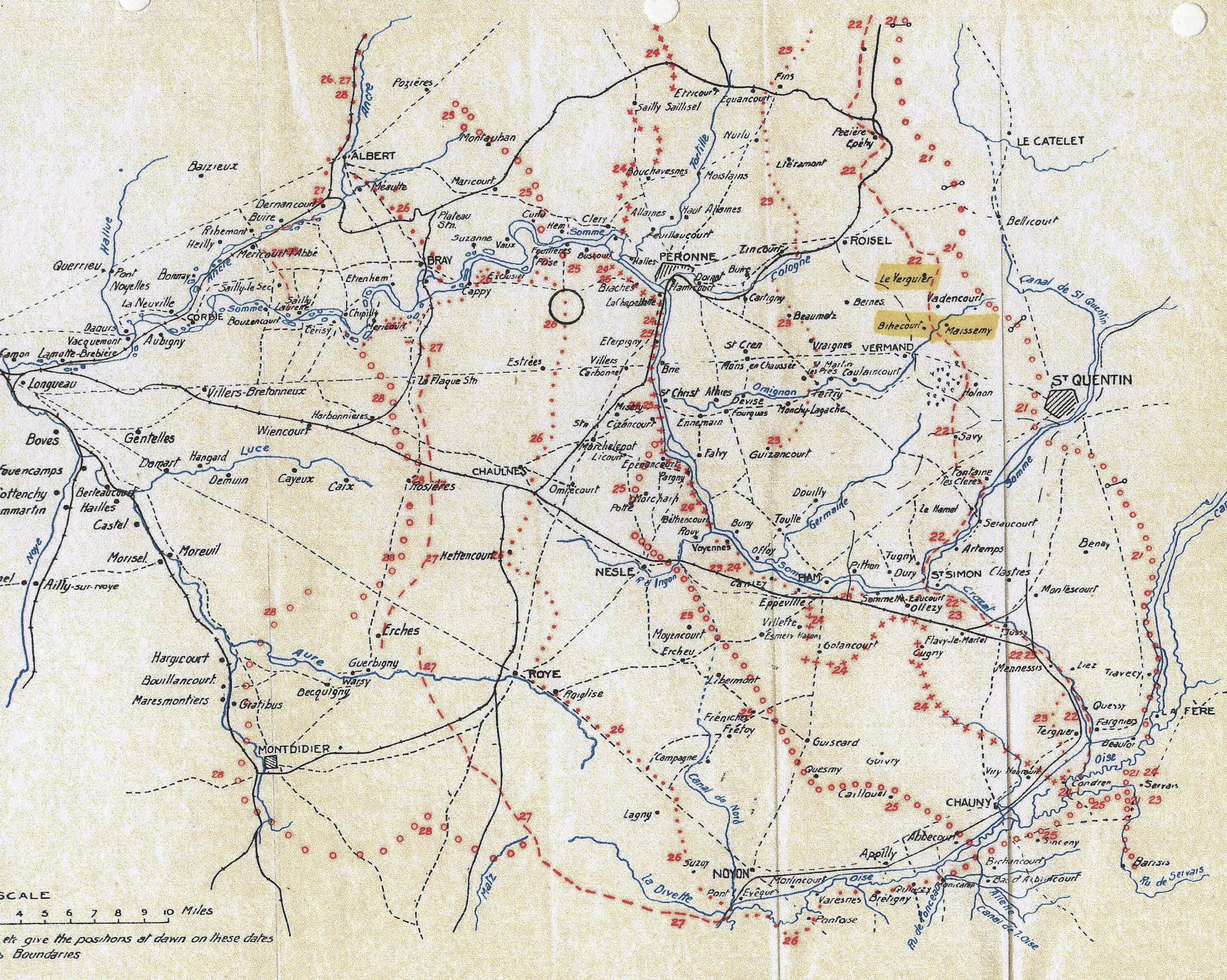
Figure 7. Map of the Western
Front, March 1918.
(Image courtesy of the Royal Engineers
Journal)
The following sections are presented in tabular form to summarize Walker’s promotions, appointments, and qualifications and the medals that he was awarded during his time in the Army. They are provided to give the reader easy access to these aspects of his military career.
5. PROMOTIONS AND APPOINTMENTS
Promotions: Walker received the following promotions during his time in service:
Date of Promotion |
|
23 December 1898 |
Second Lieutenant, upon commissioning. |
25 July 1901 |
Promoted Lieutenant. |
23 December 1907 |
Promoted Captain. |
22 June 1915 |
Promoted Major. |
20 May 1917 |
Appointed Acting Lieutenant Colonel. |
Appointments: Walker received the following appointments during his time in service:
Date of Appointment |
|
3 April 1901 |
Appointed Garrison Engineer, Military Works Service. |
15 October 1903 |
Appointed Section Commander, Indian Sappers and Miners Field Company. |
19 June 1905 |
Appointed Assistant Engineer, North Western State Railways, India. |
July 1909 |
Appointed Temporary Executive Engineer, North Western State Railways, India. |
January 1910 |
Appointed Acting Commander, 26th Indian Railway Company. |
14 November 1914 |
Appointed Adjutant, 18th Divisional Engineers. |
20 May 1917 |
Appointed Commander, 24th Divisional Engineers. |
MEDALS, AWARDS AND DECORATIONS
As previously indicated, Walker was awarded the Tibet Medal, 1903-1904 for his service with the Younghusband expedition. For his service in the Great War he was awarded the 1914-15 Star, British War Medal and Victory Medal with Mention in Despatch oak leave. In addition, on 3 June 1918 he was posthumously awarded the Distinguished Service Order (D.S.O.), one of the 1918 Birthday Honours for King George. This award was published in the Supplement to the London Gazette of 3 June 1918. His Medal Index Card shows that the trio of Great War medals were sent to his wife on 27 July 1922 at 5 Sussex Court, Bexhill-on-Sea, Sussex. She probably also received a Memorial Plaque at about this same time as well as his D.S.O. Unfortunately Walker never saw any of these medals except for the Tibet medal.
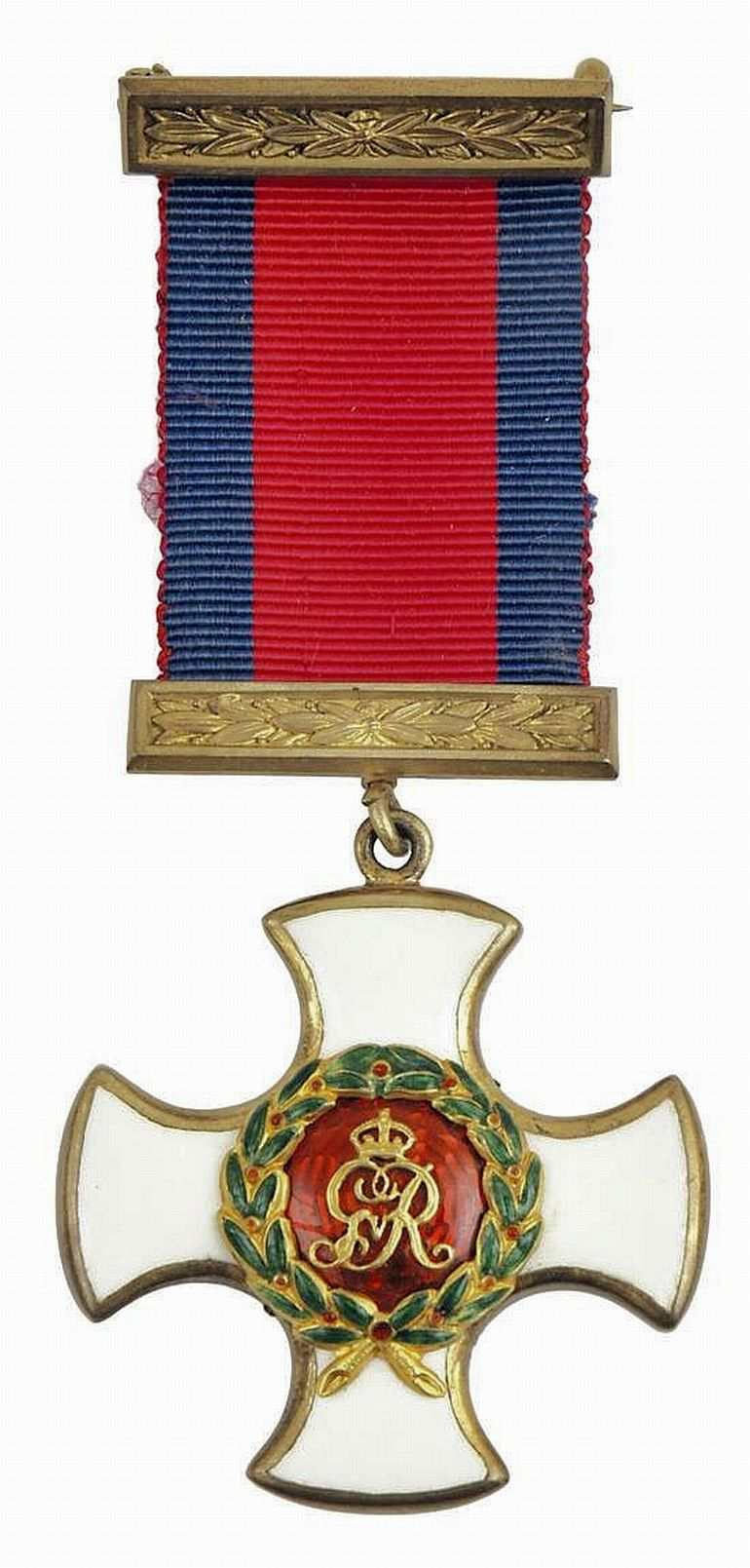
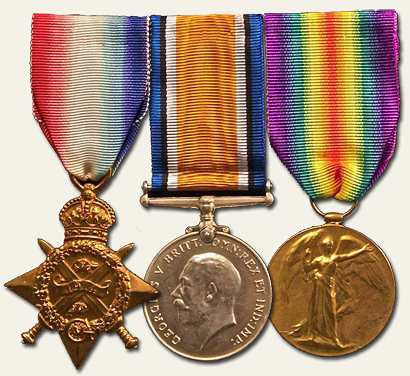
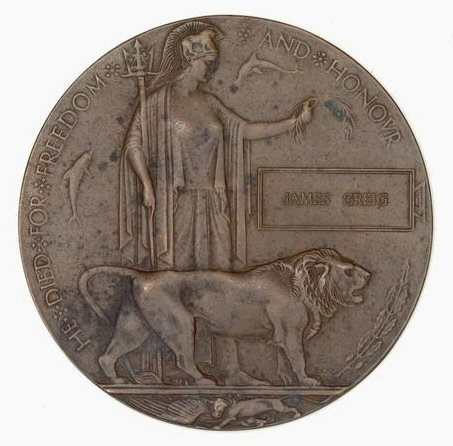
Figures 8, 9 and 10. The
Distinguished Service Order, 1914-15 Star, British War Medal and
Victory Medal without the Mention in Despatches Oak Leaf, and the
Memorial Plaque.
(Images from the author’s collection)
NOTE: These are not the medals and plaque of Lieutenant Colonel Arthur Dunbar Walker. They are presented here for illustrative purposes only.
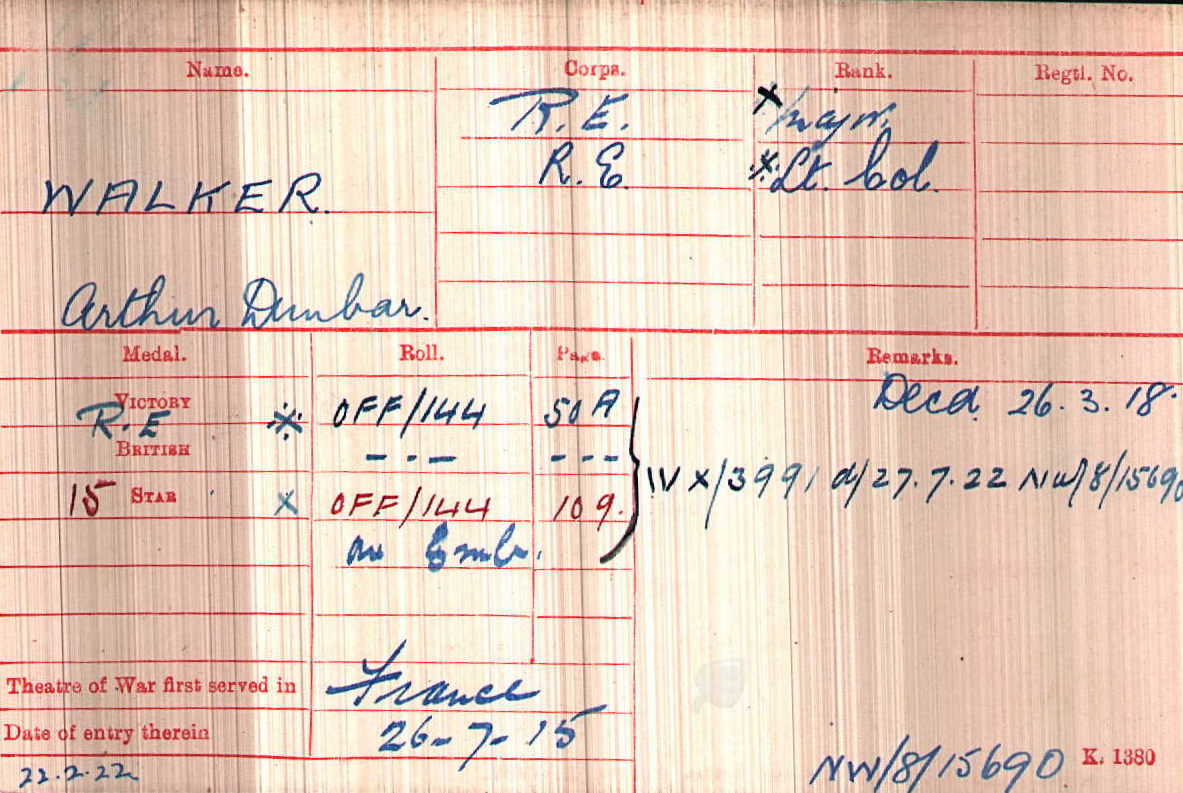
Figure
11. The Medal Index Card of Lieutenant Colonel Arthur Dunbar Walker,
R.E.
(Image courtesy of Ancestry.com)
Probate of Walker’s Will took place in London on 18 June 1919 with his effects of £1918, 9 shillings and 7 pence (about $136,400 US in 2023 currency) going to his widow, Ethel Muriel Walker at Yewdale, Lee-on-Solent, Hampshire.
EPILOGUE
When reading about Walker’s service in Tibet and in France I got the feeling that I was writing the story of a gallant officer and soldier, one who would have reached a much higher rank than Major (Acting Lieutenant Colonel) had he survived the Great War. He seemed like the type of officer who would have been concerned about the welfare of his men and his subordinate units. This concern could have well cost him his life during the retreat of the Fifth Army during the German spring offensive in 1918. Unfortunately there was no one to witness his demise and no one has written any accounts of his heroism. I hope that what I have written here brings some credit upon the service of this brave man.
ADDENDUM NO. 1
Major Arthur Dunbar Walker served as the Adjutant of the 18th Divisional Engineers in France from 26 July 1915 to 20 May 1917. The fatal casualties suffered by the units of the 18th Divisional Engineers during Walker’s time with the division consisted of the following:
· HQ, 18th Divisional Engineers: 1
· 18th Divisional Signal Company: 2
· 79th Field Company: 15
· 80th Field Company: 17
· 92nd Field Company: 23
Total: 58
These casualties included the following six officers:
· Lieutenant Colonel Henry May Henderson, the Commander Royal Engineers of the division (10 February 1917). Henderson would have been Walker’s immediate superior. After Henderson’s death, Walker would have acted as the C.R.E. for some period of time.
· Lieutenant Alan Wilson (25 August 1915) in the 79th Field Company.
· Lieutenant Richard Colin Christie (15 December 1915) in the 80th Field Company.
· Lieutenant Desmond Hague Inman (17 February 1917) in the 80th Field Company.
· Second Lieutenant Ralph Gibb Dyer (23 February 1917) in the 92nd Field Company.
· Captain J.A. Field (13 July 1916) in the 92nd Field Company.
On 20 May 1917 Walker was posted to the 24th Division as the Commander Royal Engineers. He was listed as missing, presumed killed on 26 March 1918. The fatal casualties suffered by the units of the 24th Divisional engineers during his time as the C.R.E. consisted of the following:
· HQ, 24th Divisional Engineers: 1 (this was Walker, 26 March 1918)
· 24th Divisional Signal Company: 10
· 103rd Field Company: 15
· 104th Field Company: 14
· 129th Field Company: 13
Total: 53
These casualties included the following six officers besides Walker:
· Second Lieutenant G.F.R. Hall (28 June 1917) in the 103rd Field Company.
· Second Lieutenant Ernest Henry Wildgoose (22 March 1918) in the 104th Field Company.
· Captain Hugh Gordon Francis, M.C. (22 March 1918) in the 104th Field Company.
· Lieutenant John Henry Hancock (9 June 1917) in the 129th Field Company.
· Second Lieutenant Eric Allan Gifford Coules (28 October 1917) in the 129th Field Company.
· Second Lieutenant W. Smith (23 November 1917) in the 129th Field Company.
During the German spring offensive in March 1918 the 24th Division suffered quite a few casualties during its withdrawal in the face of the enemy advance. The companies suffering the most losses during the period 21 to 27 March 1918 were the 24th Divisional Signal Company (26.6% of all casualties during the war) and the 104th Field Company (25.7% of all casualties during the war). The 103rd Field Company lost only one man and the 129th Field Company completed the withdrawal without losing a man during this period.
ANNEX
A
The Service of Major William Archibald Smail Walker
46th
Punjabis, Indian Army
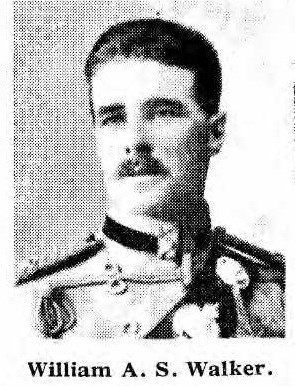
Figure
12. As a Major, 46th Punjabis.
(Image
from De Ruvigny's Roll of Honour)
William A.S. Walker was the second son of Major General Alexander Walker, C.S.I., R.A., the Director General of Ordnance in India from 1890 to 1897. He was born in Dum-Dum, India on 31 October 1874.
William was educated at Dulwich College and at the Royal Military College at Sandhurst. He was gazetted a 2nd Lieutenant, unattached, in the Indian Army on 10 October 1894 and was subsequently attached to the 1st Battalion, Somerset Light Infantry for his first year of service. He entered the Indian S.C. on 10 January 1896 and was promoted Lieutenant on 27 November 1897, Captain on 10 October 1903 and Major on 10 Oct 1912.
Major Walker served with the 45th Sikhs and then with the 40th Pathans and was posted to the 46th Punjabis when that regiment was formed. He served in campaigns on the North West Frontier of India, 1897-1898, including the Defence of Malakand, the action at Landakai and operations in Bajaur and in the Tirah Expedition, 1897-1898.
He was employed with the King’s African Rifles from 25 November 1903 to 10 May 1906. After the outbreak of the European War he was sent in January 1915 with a double company to British East Africa and was attached to the 130th Baluchis (King George’s Own). According to the write up in De Ruvigny's Roll of Honour, Walker:
“was commanding a section of the outpost line with headquarters at Mzima on the Tsava River. While visiting sentry groups with an escort of seven men on 12 April 1915, he came on the spoor of a large party of Germans. He followed this up for some way in order to locate the enemy. In returning he was ambuscaded by a smaller party of Germans who were following the main force, and he and two men were shot. He was buried on the banks of the Tsava River – the grave was marked by a cairn of stones; the two men who fell with him are buried by his side.”
NOTE: This description of William Walker’s death varies from that above, obtained from the Great War Forum. The GWF description makes it appear that Walker did something foolish by shooting at an animal and alerting the German troops to the presence of his section. Which description is most accurate is not known.
Walker’s brother officers had this to say about him:
“I knew him for a fearless man. He was with my regiment in the Tirah Expedition, 1897 – I have never met a braver soldier.”
“His escort, Dogras and Gurkhas, five of whom managed to get away, all bear great testimony to his fearlessness and gallantry. He gave the orders with his last breath for his men to scatter; such is necessary in the bush. He is a great loss to us and to our country – we can ill spare such men.”
With testimonies like this from men who knew him, one wonders whether Walker would have done something as foolish as discharging his weapon unnecessarily when on patrol and alerting the enemy to the presence of his men and himself.
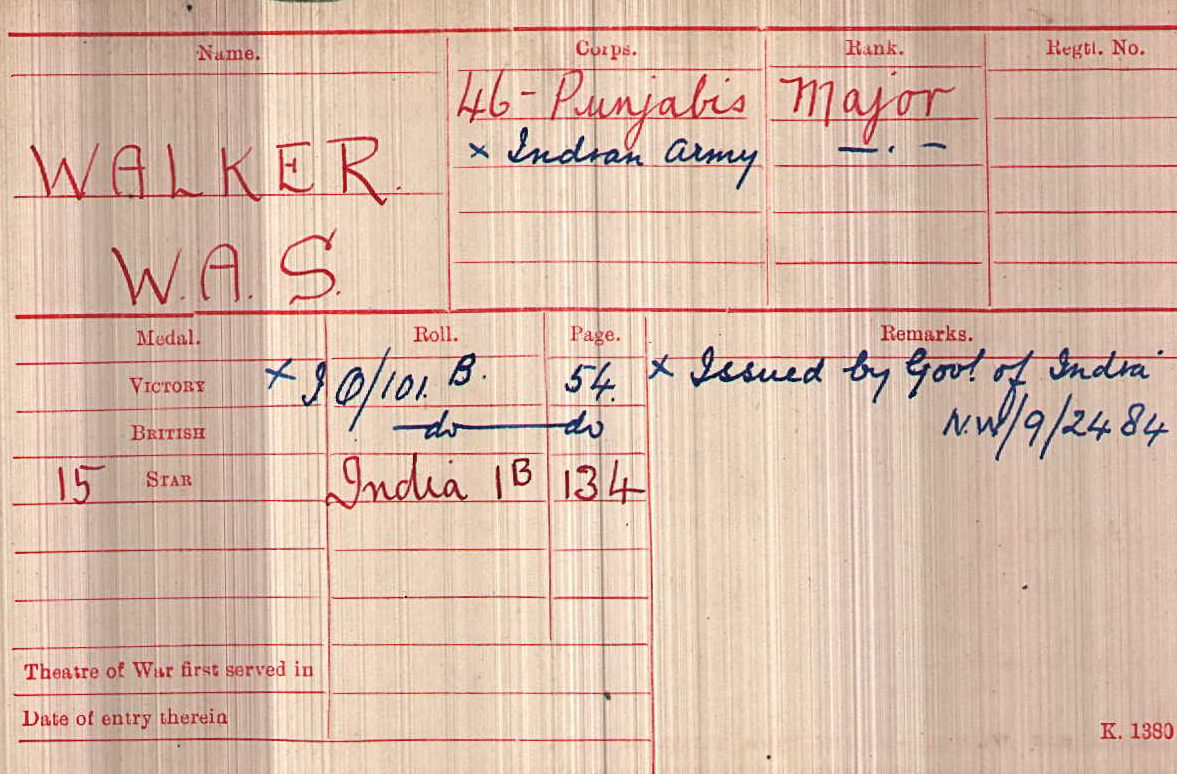
Figure
13. The Great War Medal Index Card of Major W.A.S. Walker.
(Image
courtesy of Ancestry.com)
ANNEX
B.
The Service of Captain Lewis Augustus Walker, R.A.M.C.
Lewis Augustus Walker was born on 6 September 1876 in India. He joined the Army to serve in the Great War and was commissioned in the Royal Army Medical Corps (R.A.M.C.). He rose to the rank of Captain before the end of the war and he served with a medical mission in Serbia, arriving there on 16 February 1915.
Although after the first year of the Great War Serbia came not only as undefeated, but as a winner, Serbia had been exhausted due to the huge human losses and due to destruction of its most prolific areas. Additionally, difficulties were multiplied by enlarged occurrences of infectious diseases. In particular, there were disastrous proportions of epidemic typhus, transmitted by Austrian troops in Bosnia. When moving Austro-Hungarian prisoners of war from Valjevo to Nis, the epidemic spread throughout the country. The epidemic was suppressed no earlier than in the spring of 1915, mostly due to the presence of medical missions from the Allied and neutral countries. Captain Walker served with one of these medical missions.
For his service during the war Captain Walker received the 1914-15 Star, British War Medal and Victory Medal.
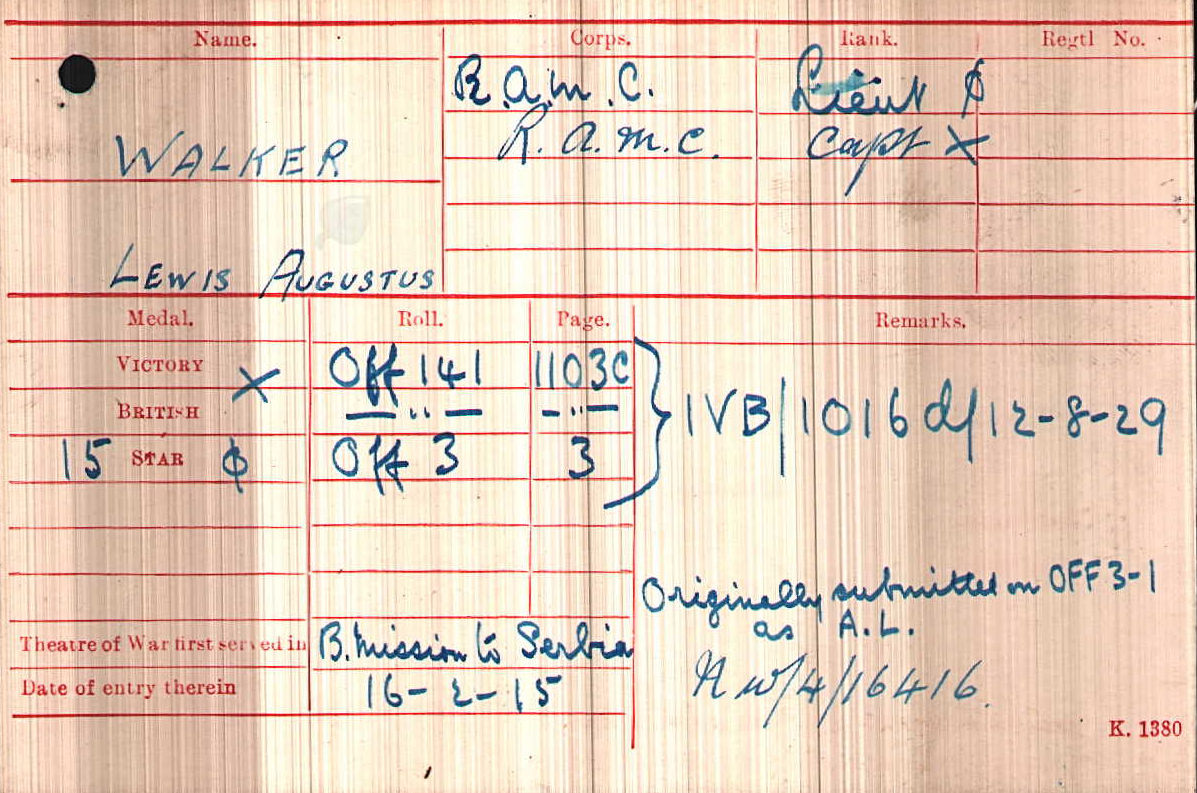
Figure
14. The Great War Medal Index Card of Captain Lewis Augustus Walker,
R.A.M.C.
(Image courtesy of Ancestry.com)
REFERENCES:
Army Lists
Monthly Army List, April 1903, p. 456.
Monthly Army List, May 1903, p. 456.
Monthly Army List, June 1903, p. 456.
Monthly Army List, January 1911, p. 892.
Monthly Army List, December 1912, pp. 243 and 797.
Monthly Army List, April 1914, pp. 243 and 797.
Hart’s Annual Army List, 1908, p. 214.
Books
Dulwich College Register, 1619 to 1926. School Register, Dulwich, 1926.
Dulwich College War Record, 1914-1919. School Register, Dulwich, 1919.
HORNBY, G. Royal Engineers Medal Roll Book, Section 6, Tibet 1903-1904. The Institution of Royal Engineers, Chatham, Kent, undated.
History of the Corps of Royal Engineers, Volume V. The Institution of Royal Engineers, Chatham, Kent, 1952.
SANDES, E.W.C. The Indian Sappers and Miners. The Institution of Royal Engineers, Chatham, Kent, 1948, pp. 420-427.
De Ruvigny's Roll of Honour, 1914-1919, Volume I, p. 363 (William Archibald Smail Walker).
Civil Documents
Dulwich College Register Form, 3990, 2 December 1924.
Letter by Mrs. Walker dated 3 August 1919.
Probate Calendar, 1916, p. 31 (W.A.S. Walker).
Probate Calendar, 1919, p. 205 (A.D. Walker).
Family Trees
Major General Alexander Walker by jcwalker134.
https://www.ancestry.com/family-tree/person/tree/70095786/person/46592216825/facts
Major General James Grant Duff Walker by jcwalker134.
https://www.ancestry.com/family-tree/person/tree/70095786/person/46592320548/facts
Arthur Dunbar Walker by jcwalker134.
https://www.ancestry.com/family-tree/person/tree/70095786/person/80014833008/facts
William Arthur Smail Walker by jcwalker134.
https://www.ancestry.com/family-tree/person/tree/70095786/person/80014832163/facts
Lewis Augustus Walker by jcwalker134.
https://www.ancestry.com/family-tree/person/tree/70095786/person/80014831922/facts
British Medical Missions in Serbia.
Internet Web Sites
Wikipedia: British Expedition to Tibet.
https://en.wikipedia.org/wiki/British_expedition_to_Tibet
Register of Employees of the East India Company and the India Office, 1746-1939.
https://www.ancestry.com/discoveryui-content/view/280409:61468
Dulwich College Record of the Fallen
https://dulwichcollege1914-18.co.uk/fallen/walker-ad/
1918 Birthday Honours.
https://en.wikipedia.org/wiki/1918_Birthday_Honours
The Long, Long Trail: 18th (Eastern) Division.
https://www.longlongtrail.co.uk/army/order-of-battle-of-divisions/18th-eastern-division/
The Long, Long Trail: 24th Division.
https://www.longlongtrail.co.uk/army/order-of-battle-of-divisions/24th-division/
London Gazette
London Gazette, 3 January 1899, p. 4.
Supplement to the London Gazette, 30 December 1914, p. 11196.
Supplement to the London Gazette, 4 January 1917, pp. 191 and 215.
Supplement to the London Gazette, 5 July 1917, p. 6680.
Supplement to the London Gazette, 3 June 1918, pp. 6457 and 6460.
Military Documents
Medal Index Card (Arthur Dunbar Walker)
Medal Index Card (Willliam Arthur Smail Walker)
Medal Index Card (Lewis Augustus Walker)
Periodicals
Battle Honours of the Royal Engineers, (18th Divisional Engineers). The Royal Engineers Journal, Chatham, Kent, 1925-1932.
Battle Honours of the Royal Engineers, (24th Divisional Engineers). The Royal Engineers Journal, Chatham, Kent, 1925-1932.
The Royal Engineers List, January 1905, p. xi.
The Royal Engineers List, December 1905, p. xi.
The Royal Engineers List, January 1908, p. xi.
The Royal Engineers List, June 1908, p. x.
The Royal Engineers List, August 1908, p. x.
The Royal Engineers List, October 1908, p. x.
The Royal Engineers List, January 1910, p. x.
The Royal Engineers List, January to December 1912, p. x.
The Royal Engineers Journal, March 1933.
Professional Papers
Radovanovic, M. British Medical Missions in Serbia 1914-1915.
ENDNOTES:
[1] Various family trees.
[2] Dulwich College Register.
[3] Army List, December 1912.
[4] On 1 April 1862 the Bengal and Madras Engineers were amalgamated with the Royal Engineers of British Indian Army. The Royal Engineers were thereafter employed in the Department of Public Works or Railways or Survey Departments and from1851 the “Public Works Department” was under civil control and no separate organization was considered necessary for military works. After 1860 there was a boom in the construction of civil works. A large number of civil engineers were engaged and the military department began to lose proper control over military works. By 1871 the situation was so unsatisfactory that a “Special Military Works Branch” of the Public Works Department was given the responsibility for major works and ten years later the branch was placed under military control. In 1889 the “Military Works Department” took over all the military works in India. However, it was not until 1899 that this Military Works Department became entirely military in character and was officered by Royal Engineers. It was then named as “Military Works Service” and so it remained until 1923 when it was renamed as the “Military Engineer Service” which continues till this day.
[5] John Claude White, C.I.E. was an engineer, photographer, author and civil servant in British India. From 1889 to 1908, White served as the Political Officer in Sikkim, then a British protectorate.
[6] Sir James Ronald Leslie Macdonald, K.C.S.I., C.B. (1862–1927) was a Scottish engineer, explorer and cartographer. He served as a British Army engineer, rose to the rank of Major-General and was knighted. A balloon observer as a young man, he surveyed for railways in India and East Africa, explored the upper Nile region, commanded balloon sections during wars in South Africa and China and led a major expedition into Tibet in 1903–1904.
[7] Later Major General, C.B., D.S.O.
[8] Later Colonel, C.B., C.I.E., D.S.O.
[9] Later Brigadier, D.S.O., M.C.
[10] Later Colonel, D.S.O.
[11] Later Brigadier General, C.M.G., D.S.O.
[12] R.E. List, 1905.
[13] Ibid.
[14] Monthly Army List, January 1911.
[15] R.E. List 1912.
[16] Medal Index Cards.
[17] Commonwealth War Graves Commission.
[18] Great War forum write-up by bushfighter.
[19] W.A.S. Walker is buried at Taveta Military Cemetery, Section III, Row B, Grave 1.
[20] London Gazette, January 1917.
[21] The Long, Long Trail.
[22] Battle Honours of the Royal Engineers.
[23] Ibid.
[24] London Gazette, July 1917.
[25] The Long, Long Trail.
[26] The Royal Engineer Journal, March 1933.